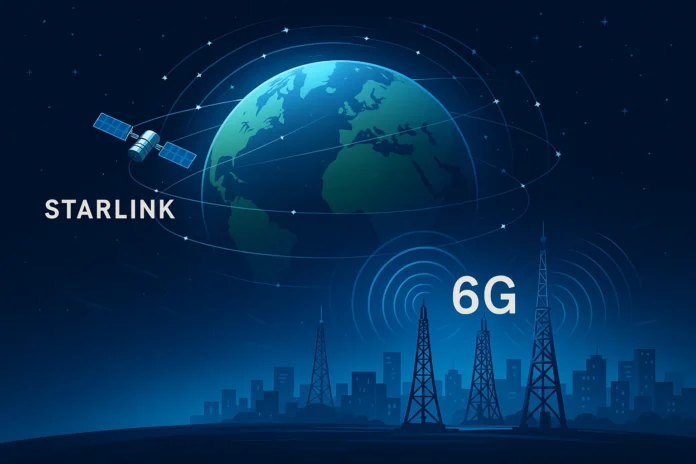
The digital landscape is on the cusp of a revolutionary transformation. As the world still acclimates to the advancements of 5G, a fascinating battle is brewing over the next generation of internet infrastructure. Two titans stand poised to redefine how we connect: 6G, the terrestrial evolution promising unprecedented speed and responsiveness, and Starlink, Elon Musk’s audacious venture to blanket the globe with high-speed satellite internet.
This isn’t merely a technological upgrade; it’s a high-stakes contest for control of the future’s data streams, economic power, and societal influence. Welcome to the digital race of the century.
📡 6G: The Terrestrial Titan Unleashed
While 5G networks continue their global rollout, the next wave of connectivity, 6G, is already generating significant buzz and investment. Nations like South Korea, China, and the United States are pouring billions into research and development, envisioning a future powered by unimaginable speeds and near-instantaneous data transfer.
Key Promises of 6G:
- Blazing Speeds: Imagine download speeds reaching up to 1 Terabit per second (Tbps) – that’s 100 times faster than what 5G currently offers!
- Near-Zero Latency: With a latency of around 0.1 milliseconds, 6G promises real-time data transfer, opening doors to applications we can only dream of today.
- Cutting-Edge Technology: At its core, 6G will leverage the largely untapped terahertz (THz) frequency spectrum, integrating artificial intelligence (AI) and enabling holographic communication.
- Revolutionary Use Cases: Prepare for real-time holographic interactions, the seamless operation of fully autonomous systems, the creation of intricate digital twins, and the potential for groundbreaking brain-computer interfaces.
However, 6G’s remarkable potential comes with a significant challenge: range. Terahertz waves have limited reach, necessitating an incredibly dense network of infrastructure. This could mean that widespread adoption in rural and remote areas might remain a distant dream without massive and dedicated investment.
🛰️ Starlink: Bridging the Digital Divide from the Skies
Taking a radically different approach, Starlink, spearheaded by Elon Musk’s SpaceX, aims to deliver high-speed internet directly from a constellation of over 5,000 satellites orbiting in Low Earth Orbit (LEO). This ambitious project promises to connect even the most geographically isolated regions – from sprawling deserts to dense forests and vast oceans.
Starlink’s Key Strengths:
- Truly Global Coverage: Starlink has the potential to reach every corner of the planet, transcending the limitations of terrestrial infrastructure.
- Competitive Latency: With current latency figures ranging between 20-40 milliseconds, Starlink is already challenging traditional 4G and even some 5G networks.
- Improving Speeds: Currently offering speeds of 100-300 Mbps in most areas, Starlink is continuously upgrading its network capabilities.
- Accessibility for All: Starlink’s ultimate vision is to bring internet access to all 8 billion people on Earth, irrespective of their location.
And Starlink isn’t the only player in this space race. Amazon’s Project Kuiper, OneWeb, and China’s Hongyun are also vying for a piece of the satellite internet pie.
Say Goodbye to Lag: 6G and Terahertz Will Redefine the Internet Forever
⚔️ The Ultimate Showdown: 6G vs. Starlink – Who Will Reign Supreme?
| Feature | 6G (Terrestrial) | Starlink (Satellite) |
| Speed | ⚡ Ultra-high (Up to 1 Tbps) | 🚀 High (~100-300 Mbps, improving) |
| Latency | 🕒 Ultra-low (~0.1 ms) | ⏱️ Moderate (~20-40 ms) |
| Coverage | 🗺️ Primarily Urban/Metro Areas | 🌍 Truly Global, including Remote |
| Infrastructure Cost | 💰 Extremely High (Dense Towers) | 💸 Moderate (Satellite-Based) |
| Setup Speed | 🏗️ Years (Tower & Fiber Deployment) | 🛰️ Months (Satellite Launches) |
| Best Use Case | AR/VR, AI, Robotics in Cities | Schools, Ships, Rural Communities |
Export to Sheets
The reality is that the future of internet connectivity might not be a winner-takes-all scenario. Instead, 6G and Starlink are likely to coexist, each catering to specific needs and environments. Densely populated urban centers with high bandwidth and low latency demands could very well embrace 6G, while Starlink could become the dominant force in connecting low-density and underserved regions.
💣 The Geopolitical Undercurrents
Beyond the technological advancements, this race for internet dominance carries significant geopolitical weight. Control over internet infrastructure translates to control over data, communication, and ultimately, influence on the global stage.
- China’s ambitious 6G initiatives are closely intertwined with its national surveillance objectives.
- The United States views Starlink as a vital tool for promoting digital freedom, even deploying it in conflict zones like Ukraine.
- India is pursuing a dual strategy, with the Bharti Group partnering with OneWeb for satellite internet and ISRO actively engaged in indigenous 6G research.
As this technological battleground evolves, we can anticipate increased cyber warfare, potential satellite sabotage, and heightened espionage activities.
🔮 A Glimpse into the Future: Convergence or Conflict?
The most promising future might lie not in competition, but in synergy. Imagine a hybrid infrastructure where:
- Ultra-low-latency 6G networks power smart cities and advanced applications.
- Satellite internet seamlessly fills the gaps, connecting remote areas and mobile platforms.
- AI-powered devices intelligently switch between the best available network in real-time.
✅ The Final Word: Connecting the Unconnected
Ultimately, the race between 6G and Starlink might not produce a single victor. Just as we have diverse modes of transportation, the future of internet connectivity is likely to be a multifaceted ecosystem. 6G will likely serve the high-demand, high-tech urban landscape, while Starlink and its competitors will play a crucial role in connecting the rest of the world – the underserved, the rural, and the mobile.
In this grand race for global internet domination, the true beneficiaries will be the billions of individuals who will finally gain access to faster, cheaper internet from virtually anywhere on Earth, and perhaps even beyond. Sources












